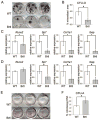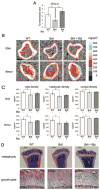Impaired osteoblastogenesis in a murine model of dominant osteogenesis imperfecta: a new target for osteogenesis imperfecta pharmacological therapy
- PMID: 22511244
- PMCID: PMC3459187
- DOI: 10.1002/stem.1107
Impaired osteoblastogenesis in a murine model of dominant osteogenesis imperfecta: a new target for osteogenesis imperfecta pharmacological therapy
Abstract
The molecular basis underlying the clinical phenotype in bone diseases is customarily associated with abnormal extracellular matrix structure and/or properties. More recently, cellular malfunction has been identified as a concomitant causative factor and increased attention has focused on stem cells differentiation. Classic osteogenesis imperfecta (OI) is a prototype for heritable bone dysplasias: it has dominant genetic transmission and is caused by mutations in the genes coding for collagen I, the most abundant protein in bone. Using the Brtl mouse, a well-characterized knockin model for moderately severe dominant OI, we demonstrated an impairment in the differentiation of bone marrow progenitor cells toward osteoblasts. In mutant mesenchymal stem cells (MSCs), the expression of early (Runx2 and Sp7) and late (Col1a1 and Ibsp) osteoblastic markers was significantly reduced with respect to wild type (WT). Conversely, mutant MSCs generated more colony-forming unit-adipocytes compared to WT, with more adipocytes per colony, and increased number and size of triglyceride drops per cell. Autophagy upregulation was also demonstrated in mutant adult MSCs differentiating toward osteogenic lineage as consequence of endoplasmic reticulum stress due to mutant collagen retention. Treatment of the Brtl mice with the proteasome inhibitor Bortezomib ameliorated both osteoblast differentiation in vitro and bone properties in vivo as demonstrated by colony-forming unit-osteoblasts assay and peripheral quantitative computed tomography analysis on long bones, respectively. This is the first report of impaired MSC differentiation to osteoblasts in OI, and it identifies a new potential target for the pharmacological treatment of the disorder.
Copyright © 2012 AlphaMed Press.
Conflict of interest statement
The authors indicate no conflict of interest.
Figures






References
-
- Forlino A, Porter FD, Lee EJ, et al. Use of the Cre/lox recombination system to develop a non-lethal knock-in murine model for osteogenesis imperfecta with an alpha1(I) G349C substitution. Variability in phenotype in BrtlIV Mice. J Biol Chem. 1999;274:37923–37931. - PubMed
-
- Kozloff KM, Carden A, Bergwitz C, et al. Brittle IV mouse model for osteogenesis imperfecta IV demonstrates postpubertal adaptations to improve whole bone strength. J Bone Miner Res. 2004;19:614–622. - PubMed
Publication types
MeSH terms
Substances
Grants and funding
LinkOut - more resources
Full Text Sources
Other Literature Sources
Medical
Molecular Biology Databases
Miscellaneous

